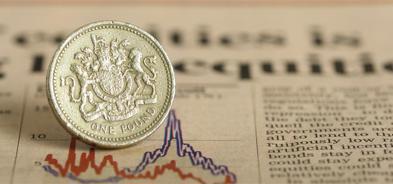The April Market Pulse
Tilney Group’s Chief Investment Officer Chris Godding discusses the macroeconomic ideas and research from April 2019.
The value of investments can fall as well as rise and that you may not get back the amount you originally invested.
Nothing in these briefings is intended to constitute advice or a recommendation and you should not take any investment decision based on their content.
Any opinions expressed may change or have already changed.
Written by Chris Godding
Published on 26 Apr 20198 minute read

Chinese credit
Credit growth in China has been a focus topic for this monthly commentary. It reached a peak of 9% year on year at the end of 2016 before the Politburo and the People’s Bank of China (PBOC) effectively intervened to avoid the very real risk of a credit bubble.
The chart below shows the secondary effects of the credit boom on interest rates as measured by the 10-year government bond yield, and business activity as measured by the manufacturing purchasing managers index post the credit boom. Both measures moved considerably higher during 2016 and 2017 before the tighter credit policy began to slow the momentum, emphasising both the long lag effects involved and the difficulty government institutions face in managing an economy in the short term.
Having succeeded in regaining control of the credit situation, the Politburo and the PBOC eased off the brakes with changes in fiscal and monetary policy late last year that should deliver higher GDP growth in the second half of this year. With total credit now around 200% of GDP, a small increase in the pace of credit growth will have a material effect on the Chinese economy, its trading partners and commodities consumed. The PMI data for March did indeed reflect a recovery in business and the recent rally in Chinese government bond yields would support that view.
While bond yields around the world have risen quite nicely from lows at the end of March, they are still well below the levels seen last autumn, implying that many investors remain sceptical of a recovery. Rather than wait for easier fiscal and monetary policies to yield results, the bull case for bond investors is that the policy makers have run out of options to combat debt, deflation and a Japanese style outcome.
Signs of a recovery
The outlook for global markets
The more positive approach is that prospects for China, and the world economy, have improved with the change in interest rate policy at the US Federal Reserve in January and the apparent progress on the Sino/US trade talks. The equity markets have definitely taken the optimistic view with the MSCI China A shares index up 33% in USD year to date and the Shanghai Composite Index up 32%, as China leads the index rankings in what has been a sharp rebound for world markets.
Over the last year the MSCI AC World Index is now up over 11% in sterling terms and nearly 7% in local currency. The dramatic losses in the final quarter of last year have been erased by a recovery that illustrates the benefits of staying invested and taking a longer term view.
World markets (indexed to 100)
It is encouraging that Europe and the Emerging Markets have led the pack over the last month rather than the US, and we believe that this trend will continue. Both geographies are recovering from a sharp slowdown in activity and what growth there has been was aided by inventory building in the face of Brexit and trade tariffs.
Easier financial conditions across the globe should lead to a cyclical rebound that has the support of a modest fiscal tailwind to kick-start growth. Faster growth in Emerging Markets and Europe should also lead to steeper yield curves and the potential of a weaker US dollar. However, this aspect of the forecast is far from certain and potentially an Achilles heel for equities.
Interest in the US dollar (Trade Weighted Index – rebased to 100)
Interest rate differentials still heavily favour investors holding US dollars, and the carrying cost of being short US dollars or long a currency like the euro is high. These rate differentials could narrow if the European Central Bank raised interest rates – which is extremely unlikely – or if the Federal Reserve (Fed) were to surprise the markets with a cut, which is possible but a very bold call at this point in the cycle.
If the Fed cuts interest rates the risk of an inflationary shock will increase significantly, so it is only likely to do so if it becomes clear that the stimulus policies outside the US are failing in their goals. Therefore, while the US dollar may stop appreciating against higher yielding currencies such as the Chinese renminbi or the Brazilian real, the interest differentials are unlikely to fall and the trade-weighted US dollar is unlikely to depreciate overall.
Global fiscal and monetary stimulus is usually a potent combination for higher yielding currencies and bonds. The emerging market debt fund in our managed portfolios reflects this positive view – the fund is up over 6.5% in the past six months alone. With the JP Morgan Emerging Market currency index still 43% below its 2011 high and barring a further rally in the US dollar, Emerging Market local currency bonds remain an attractive risk asset in a low return world.
Emerging bonds
The US yield curve and the possibility of a recession
A fair amount of research over the past month has been focused on the fact that the US yield curve inverted momentarily during March, with many investors seeing this as a sign of imminent recession. A yield curve inverts when the yield on a long-term bond falls below the yield of a shorter term bond and most investors compare the yield on the 10-year and 2-year bonds respectively.
Historically, the inversion has been a reliable indicator that a recession is likely within the next 12-18 months, the rationale being that there is no incentive to invest and hence the excitement and sucking of teeth. However, a 2-10 inversion is not 100% reliable as an indicator and the efficacy depends on three key factors:
- The response of the Central bank around the time of the inversion
- The term premium in 10-year bonds
- The length of time the curve is inverted
In this instance, the Federal Reserve was fortunate to find itself on the front foot with regard to the policy response, as it had lowered interest rate expectations materially ahead of the inversion due to the slowdown in growth outside the US. The inversion would also not have happened at all if the term premium of the 10-year bond was not artificially low as a consequence of quantitative easing that reduces 10-year yields by around 0.75%. Finally, the curve was only inverted for a day. Therefore, we discount the reliability of the indicator at this stage.
A global economic recovery?
For the moment, the global economy is beginning to stabilise and we expect earnings revisions to follow suit relatively soon. In this respect there is more potential for non-US economies to deliver given the capacity constraints in the US market and wage pressures we see there.
International stocks are a better prospect in terms of valuation and momentum, bar Japan where the prospect of an increase in VAT planned for October is a concern. According to BCA, over 50 % of global leading indicators are positive now and commodity prices also indicate a cyclical recovery.
Inflation
Inflation in the US and the Fed’s response is potentially a danger. There are very few signs of endemic inflationary pressures at present but if signs did emerge, the Fed is likely to be overly cautious, very gradual and measured with a preference for overheating rather than over tightening.
Inflation is the dog that hasn’t barked and perhaps the limited capacity for further debt accumulation under current banking regulations and the US Government debt ceiling will act as a natural constraint.
Inflation is a result of change in the velocity of money, the quantity of money and quantity of goods. All three are relatively stable at present and have limited upside when the levels of debt across the consumer, government and corporations is so high.
Where now for US profit margins? (%)
Companies will find it difficult to pass on input price inflation in such conditions of muted end demand and margins become the silent enemy of the markets as they come under pressure. This argument supports the preference for markets outside the US where valuations are cheaper and economic potential in the form of excess capacity is higher.
The risk to our approach is a melt-up in the US and if we enter bubble territory we are likely to lag the crowd. The managers we invest with seek companies with sustainable business models that hold their margins to preserve and grow capital. They tend to avoid unicorns who “blitzscale” the investment plains for market share at any cost. Our equity asset allocation, while positively skewed towards equities, also favours the protection of value as a margin of safety as opposed to the fear of missing out. Experience has taught me that if we fall, it is less painful when closer to the ground.
Equity inflows so far this year do not suggest we should be concerned about excessive exuberance at this point despite a number of equity indices at or approaching new highs. The May-September seasonality is typically negative for equities but year to date investors have been net sellers of equities (-US$91 billion) and net buyers of bonds (+US$120 billion). What is equally surprising is that Europe is the best-performing equity region so far this year despite having the highest net outflow of net investment (-US$47 billion)!
CITI Global Earnings Surprise Index
The implication of this divergence is that despite the fact that global earnings revision turned up in February, many investors are yet to be convinced that the economy and earnings growth rate will recover in the second half of the year. Only when we see the fund flow reverse and the bears capitulate will we be more cautious and looking to lighten up on risk.
For more information or if you have any questions, please get in touch by calling 020 7189 2400.
Important information
All graph data from Bloomberg, 26/04/2019.
Get insights and events via email
Receive the latest updates straight to your inbox.
You may also like…

Investing
Seven investing principles for DIY investors in volatile markets





